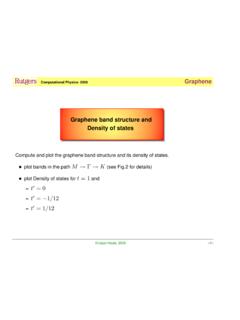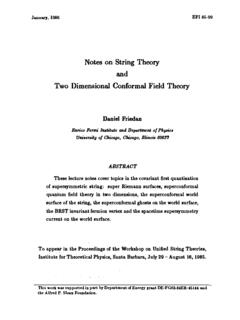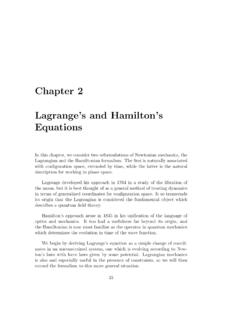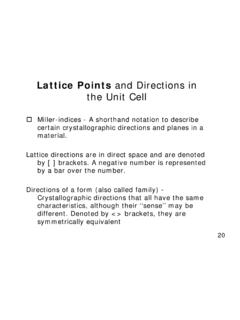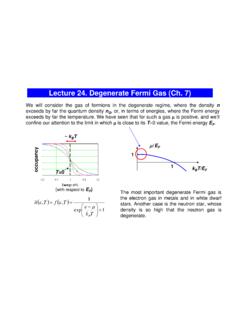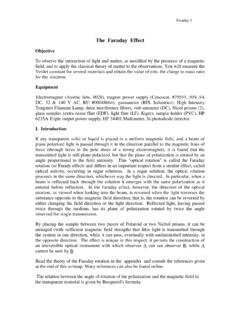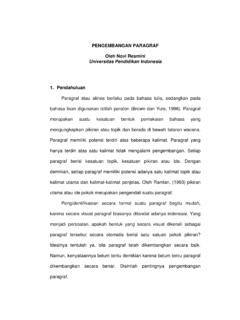Transcription of Chapter 4 SU(2) - Rutgers University
1 Chapter 4SU(2) Representations of SU(2) We will now work out in detail the properties of SU(2) and its have already seen that the generators may be chosen to beLi=12 i,with i= the Pauli ijkare the structure constants, and ij= aib bja= 2 our generators are not quite canonically normalized, but are all nor-malized equally, and is positive definite. This is related to the fact, whichwe have already seen, that the group is writing down our generators, we have chosen, arbitrarily, one directionto make diagonal. Any rotation can be, by similarity transformation with atrotation, rotated into thezdirection, so as we have a choice as to which ofthe infinite number of equivalent representations to choose, we may chooseL3to be we had several generators which commuted with each other,we couldhave chosen all of them to be diagonal.
2 In general, we will take a maximalset of commuting generators, called theCartan subalgebra, and representthem as SU(2), no rotations about any other axis commute withL3, so theCartan subalgebra is one Last Latexed: April 25, 2017 at 9:45 Joel A. ShapiroWe want to look for finite dimensional irreducible representations, andwe have chosen to make (L3) diagonal. Consider a basis vectoremwithL3em=mem, or m m(L3) =m m m, where so far we are not restrictingmother than to say it is real. However, we know thate4 iL3= 1I, soe4 im= 1,andm=n/2 for some integern, for us to have a true representation of theSU(2) group.
3 But even without assuming this, we will find it anyway, fromrequiring the representation to be finite can form the two operatorsL =L1 iL2 are not actually part of the Lie algebra, because that is defined over thereals, but any representation of the algebra is automatically a representationof the complexification, { vaLa},va are called raising and lowering operators respectively because[L3,L ] =1 2[L3,L1] i 2[L3,L2] =i 2L2 1 2L1= L .Thus ifL3em=mem,L3(L em) = (L L3 L )em= (m 1)L em,soL emis a new basis vector of the representation, unless it +an arbitrary number of times generates an arbitrary numberof vectors unless at some point it gives 0.
4 All of these vectors are linearlyindependent, so we would generate an infinite-dimensional space unless thereexists some stateej Lp+emwithL3ej=jejon whichL+ej= calledthehighest weight us form a normalized vector proportional toejcalled1|j,ji, and writethe inner product in quantum mechanical formhj,j|j,ji= we generate a sequence of orthonormal states|j,mi=Nj,mLj m |j,ji,1If there are several eigenvectors with eigenvaluem, add a label to the states generatedbyL+, so the highest weight ones will be|j, j, i, but the states with different will turnout to be in different irreducible representations, as :Last Latexed: April 25, 2017 at 9:4569whereNj,mis a real normalization constant not quite the same as Georgi state|j,miis an eigenstate ofL3with eigenvaluem,L3|j,mi=m|j,mibecause each application ofL lowers the eigenvalue ofL3by normalization factors can be found by observing that|j,mi=L |j,m+ 1iNj,mNj,m+1 N 1m+1in GeorgiorL |j,m+ 1i=Nm+1|j, the other hand,L+|j,mi=Nj,mL+Lk |j,jiwithk=j m=Nj,m(k 1 r=0Lk 1 r [L+,L ]Lr |j,ji+Lk L+|j,ji).
5 But [L+,L ] =12[L1+iL2,L1 iL2] =i[L2,L1] =L3andL3Lr |j,ji=(j r)Lr |j,jiasL is the lowering operator. So asL+|j,ji= 0,L+|j,mi=Nj,mk 1 r=0(j r)Lk 1 |j,ji=[kj k(k 1)2]Nj,mLk 1 |j,ji=k[j k 12]Nj,mN 1j,m+1|j,m+ 1i=12(j m)(j+m+ 1)N 1m+1|j,m+ +=L , sohj,m+ 1|L+|j,mi=hj,m|L |j,m+ 1i ==12(j m)(j+m+ 1)N 1m+1=Nm+12 The state|j, m, iso generated will be proportional to the originalembecause[L , L+] = L3andemis an eigenstate ofL3. Thus all the states generated have thesame .70. Last Latexed: April 25, 2017 at 9:45 Joel A. ShapiroorNm+1=1 2 (j m)(j+m+ 1)Nm=1 2 (j m+ 1)(j+m).Now the set of states|j,mim=j,j 1,j 2.
6 Must terminate somewhereif the representation is to be finite dimensional, so for somem < j,Nm=0,soj+m= 0, orm= j. Butj mis an integer, so 2jis an integer, andhence 2mis an integer as have formed a representation with orthonormal basis{|j,mi,m=j,j 1,j 2, , j}, which is 2j+ 1 dimensional, with 2jan integer. Wefound the representation ofL3andL , from is exactly one irreducible representation of SU(2) for each dimen-sion and for eachj= 0,12,1,32,.. Each representation has just one eigen-state ofL3with each eigenvaluem [ j, j+ 1,..,j]. The representationis given byL3|j,mi=m|j,miL+|j,mi=1 2 (j m)(j+m+ 1)|j,m+1iL |j,mi=1 2 (j+m)(j m+ 1)|j,m 1ithe representation of the group elements is, of course, given by the exponen-tial of the representation of the generators.
7 The 2j+ 1 dimensional repre-sentation is usually denotedDjm1,m2(g)Thej=12representation is just the group elements themselves. Thereforeit is called thedefining that if we started with 2 orthogonal statesem, andem, , all the states wegenerated fromem, would be orthogonal to all those fromem, , and the first set by itselfwould be an irreducible :Last Latexed: April 25, 2017 at 9 Reduction of Direct ProductsIf 1and 2are two representations of a Lie group, and is their directproduct, then (ix),(jy)(g) = 1ij(g) 2xy(g).Recalling that4 (La) = iddva (g(va)) v=0g=1, (ix),(jy)(L) = 1ij(L) 2xy(1I) + 1ij(1I) 2xy(L) = xy 1ij(L) + ij 2xy(L).
8 Now for SU(2), consider the direct product states with bases|j1,j2;m1,m2i=|j1,m1i |j2, representation can in principle be decomposed into a set of irreduciblerepresentations|j,mi. To see which, we count the dimensionality of theeigenspaces ofL3,L3|j1,j2;m1,m2i= (L3|j1,m1i) |j2,m2i+|j1,m1i (L3|j2,m2i)= (m1+m2)|j1,m1;j2, our states are already eigenstates ofL3. The largest eigenvalueisj1+j2, which can occur in only one way. So the representationj=j1+j2occurs exactly once in the direct product. This representation accounts forone of the basis vectors for eachm(= eigenvalue ofL3) with|m| j1+ considerm=m1+m2=j1+j2 1.
9 There are two ways to buildit up, withm1=j1 1,m2=j2, or withm1=j1,m2=j2 1, as long aseachjis at least12. The next higherm,m=j1+j2 2, can be built threedifferent ways. The growth stops withm=j1+j2 k, which can be writtenink+ 1 ways, withm1=j1 r,m2=j2 k+r,r= 0,..,k. What stopsit is that we must requirem1 j1, andm2 j2, sok 2 min(j1,j2).After that, themcorresponding to the smallerj(sayjmin=k/2)) takes onall 2jmin+ 1 values, until we get tom < |jmax jmin|, where the possiblevalues ofmfor the smallerjare have added the ito get physicist s Last Latexed: April 25, 2017 at 9:45 Joel A. ShapiroExample:j1= 5/2j2= 1 Thus the dimension-ality of themsub-space is min(j1+j2 |m|+ 1,2jmin+ 1).
10 Mwaysm=m1+m2number7/25/2 + 115/25/2 + 0; 3/2+123/25/2 + ( 1); 3/2+0; 1/2+131/23/2 + ( 1); 1/2+0; 1/2+13 1/21/2 + ( 1); 1/2+0; 3/2+13 3/2 1/2 + ( 1); 3/2+0; 5/2+13 5/2 3/2 + ( 1); 5/2+02 7/2 5/2 + ( 1)1 Each decrease ofmgives a new state, which is the highest state of a newrepresentation, up to the point wherej1+j2 m+ 1 = 2jmin+ 1,or|m|=jmax jmin=|j1 j2|.Thus j1 j2 =j1+j2 j=|j1 j2| statement is an equivalence, so there must be a unitary matrixUwhichconnects the direct product to the direct sum. This matrix has a right indexwhich is a pair (m1,m2) and a left index which must specify which irreduciblerepresentation in the sum is referenced, and whichmfor that eachjin the sum appears only once, we can usejto index therepresentation.
